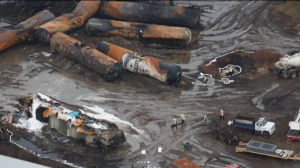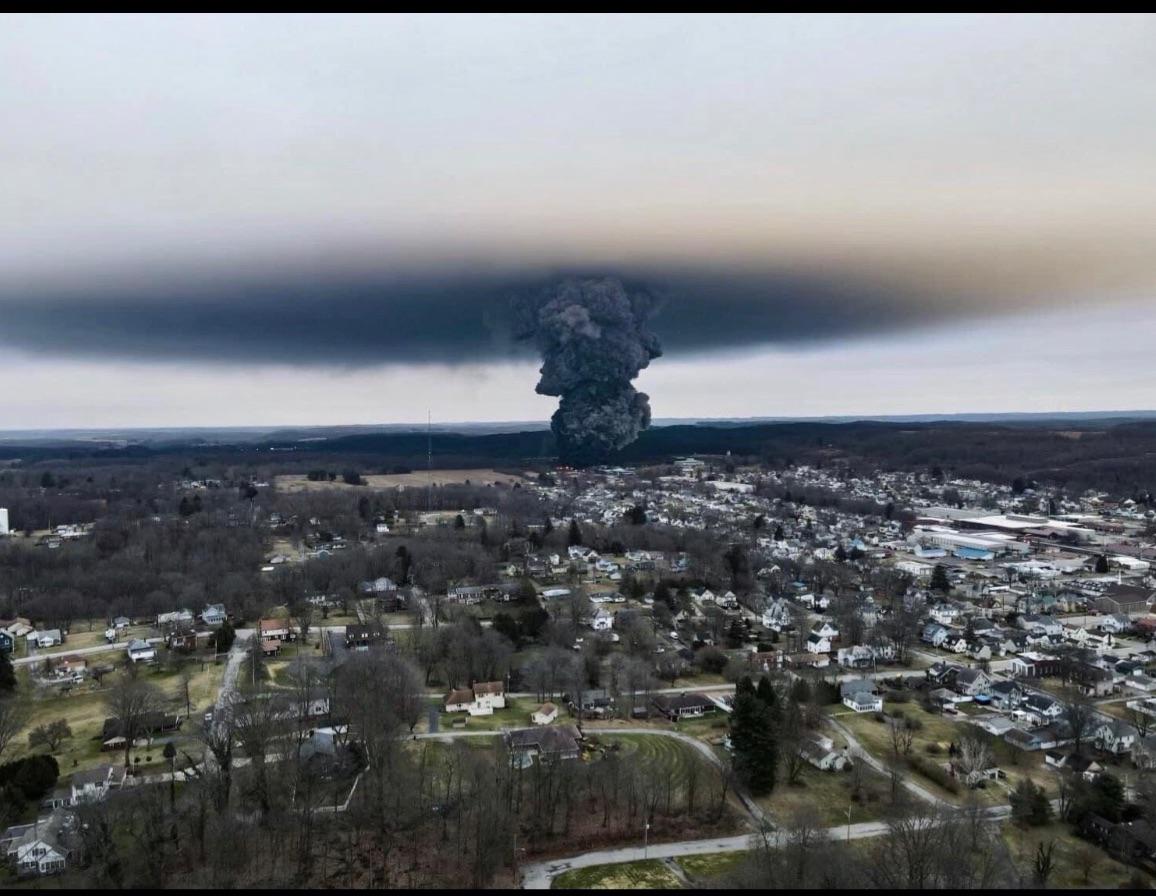Derailed train nuked Ohio town
East Palestine Ohio nuked by train derailment causing chemical spill and dark plume descend on town and wildlife
About 50 cars, including 10 carrying hazardous materials, derailed in a fiery crash
Ethylene glycol monobutyl ether, ethylhexyl acrylate and isobutylene where in rail cars
Ethylhexyl acrylate is a carcinogen that can cause burning and irritation of the skin and eyes
Isobutylene is also known to cause dizziness and drowsiness
Vinyl chloride released into the air crews ignited to burn off causing dark rolling plume of smoke

“We basically nuked a town with chemicals so we could get a railroad open,” said Sil Caggiano, a hazardous materials specialist.
Three more chemicals have been found on the Norfolk Southern train that derailed in East Palestine, Ohio, in early February, and they are being described as dangerous.
“We basically nuked a town with chemicals so we could get a railroad open,” said Sil Caggiano, a hazardous materials specialist.
The U.S. Environmental Protection Agency (EPA) sent a letter to Norfolk Southern stating that ethylene glycol monobutyl ether, ethylhexyl acrylate and isobutylene were also in the rail cars that were derailed, breached and/or on fire.
The freight train derailment on Feb. 3 near the Pennsylvania state line left a mangled and charred mass of boxcars and flames as authorities launched a federal investigation and monitored air quality from the various hazardous chemicals in the train.
Enjoying our insights?
Subscribe to our newsletter to keep up with the latest industry trends and developments.
Stay InformedEthylhexyl acrylate is especially concerning since it’s a carcinogen and contact with it can cause burning and irritation of the skin and eyes, Caggiano said. Breathing it in can irritate the nose and throat and cause coughing and shortness of breath.
Isobutylene is also known to cause dizziness and drowsiness when inhaled.
In a statement announcing the evacuation order, Ohio governor Mike DeWine warned that people closest to the derailment faced “grave danger of death.”

About 50 cars, including 10 carrying hazardous materials, derailed in a fiery crash. Vinyl chloride was later released into the air before crews ignited it to get rid of the highly flammable, toxic chemicals in a controlled environment, creating a dark plume of smoke.
“I was surprised when they quickly told the people they can go back home, but then said if they feel like they want their homes tested, they can have them tested. I would’ve far rather they did all the testing,” Caggiano said.
Caggiano said it’s possible some of these chemicals could still be present in homes and on objects until they are cleaned thoroughly.
“There’s a lot of what-ifs, and we’re going to be looking at this thing five, 10, 15, 20 years down the line and wondering, ‘Gee, cancer clusters could pop up, you know, well water could go bad,’” Caggiano said.
Caggiano recommends that anyone in the East Palestine area should get a health check-up so there is documentation in the event of any effects possibly related to the train derailment.
About 50 cars, including 10 carrying hazardous materials, derailed in a fiery crash. Vinyl chloride was later released into the air from five of those cars before crews ignited it to get rid of the highly flammable, toxic chemicals in a controlled environment, creating a dark plume of smoke.
Residents from nearby neighborhoods in Ohio and Pennsylvania were evacuated because of health risks from the fumes, but have since been allowed to return.
February 5, 2023: NTSB Investigators conduct Unmanned Aircraft System operations for the Norfolk Southern freight train derailment near East Palestine, Ohio.
According to the Federal Railroad Administration (FRA) Office of Safety Analysis, there were a total of 1,526 railroad derailments in the United States in 2010, and 1,048 derailments in 2020. It is important to note that these figures include all types of derailments, including those involving passenger and freight trains, and those that occur on mainline tracks and within rail yards.
It is also worth mentioning that while the total number of derailments has decreased over the past decade, the severity of some individual incidents may vary. In addition, some derailments may go unreported or may not be included in official statistics.
It’s important to note that not all of these derailments would be considered “catastrophic.” In fact, most derailments result in only minor damage or no damage at all.
It’s also worth noting that the number of derailments per year can vary widely. The reasons for these fluctuations can be complex and multifaceted, and can depend on a range of factors such as weather conditions, maintenance practices, and human error.
Overall, it’s important to recognize that even a single derailment can have serious consequences, both in terms of the potential for injury or loss of life, and in terms of economic impact. So it’s crucial that railway companies and regulators remain vigilant in their efforts to promote safety and prevent derailments whenever possible.
A train derailment in Ohio is currently emitting massive amounts of carcinogenic compounds into the air, this alone would be enough to be interesting but it seems there is more to the story. Norfolk Southern seems to be operating hand in hand with the government in this area,… pic.twitter.com/WZyNGIYKYX
— Mises Caucus (@LPMisesCaucus) February 12, 2023
Dangers of Exposure to Ethylene Glycol Monobutyl Ether
The primary route of exposure to EGBE is inhalation, as the compound can evaporate quickly into the air at room temperature. Acute exposure to high levels of EGBE vapor can cause irritation of the eyes, nose, and throat, as well as headaches, dizziness, and nausea. Prolonged or repeated exposure to EGBE can lead to more serious health effects, such as damage to the liver, kidneys, and blood, and reproductive system.
In addition to inhalation, skin contact with EGBE can also cause harm. Prolonged or repeated contact with the skin can result in irritation, redness, and even chemical burns. EGBE is also known to be toxic to aquatic life, so it is important to dispose of the chemical properly to avoid environmental damage.
Dangers of Exposure to Ethylhexyl Acrylate
The primary route of exposure to ethylhexyl acrylate is through inhalation of its vapors, which can irritate the eyes, nose, throat, and lungs. Prolonged or repeated exposure to high levels of ethylhexyl acrylate can also cause more serious health effects, such as damage to the liver, kidneys, and blood, as well as respiratory problems and skin sensitization.
In addition to inhalation, skin contact with ethylhexyl acrylate can also cause harm. Prolonged or repeated contact with the skin can result in irritation, redness, and even chemical burns.
Ethylhexyl acrylate is also highly flammable and can form explosive mixtures with air, posing a significant fire and explosion hazard.
Dangers of Exposure to Isobutylene
The primary route of exposure to isobutylene is through inhalation of its vapors, which can cause irritation of the respiratory system, eyes, and skin. High levels of isobutylene exposure can cause more serious health effects, such as headaches, dizziness, nausea, and even asphyxiation. Isobutylene can also cause frostbite or skin burns upon contact with the skin or eyes.
Isobutylene is also highly flammable and can form explosive mixtures with air, posing a significant fire and explosion hazard.
To minimize the risks associated with isobutylene, it is important to follow proper safety precautions, such as ensuring proper ventilation when using the compound, wearing appropriate personal protective equipment (PPE), and handling the compound in areas that are specifically designed for its use. It is also important to handle and store isobutylene in accordance with local and federal regulations to prevent environmental contamination.
Dangers of Exposure to Vinyl Chloride
The primary route of exposure to vinyl chloride is through inhalation of its vapors, which can cause irritation of the respiratory system, eyes, and skin. High levels of vinyl chloride exposure can cause more serious health effects, such as central nervous system depression, headache, dizziness, and even unconsciousness. Vinyl chloride is also classified as a human carcinogen and has been associated with an increased risk of liver cancer, particularly in workers exposed to the gas for prolonged periods.
Vinyl chloride can also pose an environmental hazard, particularly if released into the air or water. It is toxic to aquatic organisms and can cause environmental contamination if released improperly.





















